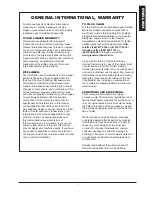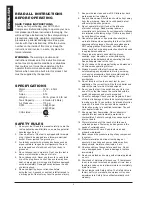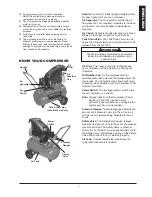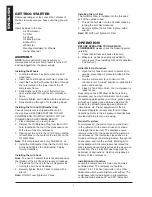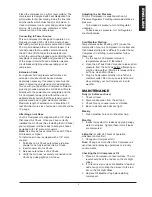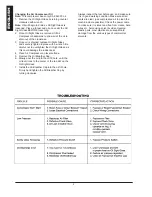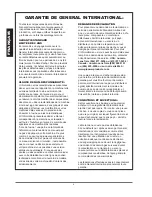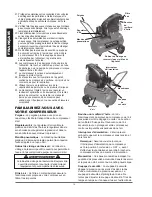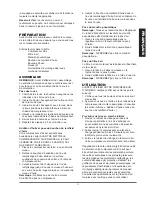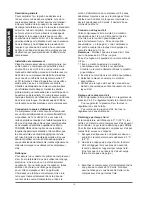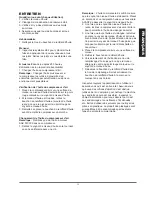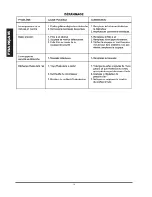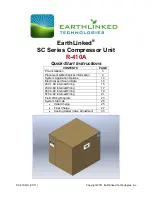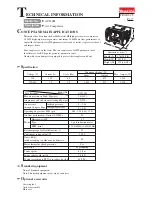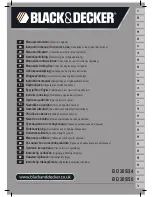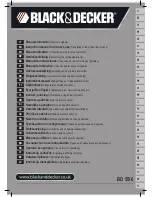
English
5
Place the compressor on a firm, level surface. The
compressor is designed with heat dissipation fins
which allow for proper cooling. Keep the fins (and
all other parts which collect dust or dirt) clean. A
clean compressor runs cooler and provides longer
service. Do not place rags, containers or other
material on top of the compressor.
Connecting to Power Source
This air compressor is designed to operate on a
properly grounded 120 volt, 60Hz, single phase,
alternating current (ac) power source with a fused
20 amp time delayed fuse or circuit breaker. It is
recommended that a qualified electrician verify
the ACTUAL VOLTAGE at the receptacle into
which the unit will be plugged and confirm that the
receptacle is properly fused and grounded. The use
of the proper circuit size can eliminate nuisance
circuit breaker tripping while operating your air
compressor.
Extension Cords
For optimum Air Compressor performance an
extension cord should not be used unless
absolutely necessary. If necessary, care must be
taken in selecting an extension cord appropriate
for use with your specific Air Compressor. Select a
properly grounded extension cord which will mate
directly with the power source receptacle and the
Air Compressor power cord without the use of
adapters. Make certain that the extension cord is
properly wired and in good electrical condition.
Maximum length of extension cord should be 50
feet. Minimum wire size of extension cord should be
12 gauge.
Attaching an Air Hose
Your Air Compressor is supplied with a 1/4" Quick
Disconnect Air Chuck. Once you have correctly
installed the Air Chuck (See Installing the Air Chuck)
your compressor will be ready to accept air hoses
equipped with 1/4" male air couplers.
Note:
Use only air hoses rated for use with 115psi
air pressure or higher.
To install an air hose, equipped with a 1/4" male
coupler:
1. Pull back on Air Chuck outer sleeve to allow
coupler to be fully inserted into Air Chuck.
2. Insert coupler into Air Chuck.
3. Release outer sleeve of Air Chuck.
4. Verify that air hose is securely connected to Air
Chuck by pulling lightly on air hose.
Adjusting the Air Pressure
Your Air Compressor is supplied with an Air
Pressure Regulator. This Regulator adjusts the air
pressure.
To increase air pressure, turn Air Regulator
clockwise.
To decrease air pressure, turn Air Regulator
counterclockwise.
Cold Weather Starting
Temperatures below freezing (32°F) cause the
metal parts of your Air Compressor to contract and
that makes starting more difficult. To assist the Air
Compressor in starting in cold weather, follow
these tips:
1. Try to keep Air Compressor stored in
temperatures above 32° fahrenheit.
2. Open the Air Tank Drain Valve and release all air
pressure from the Air Tank before attempting to
start in cold weather. (After air is released from
Air Tank, close Drain Valve.)
3. Plug Air Compressor directly into a 120 volt
electrical outlet. Do not use an extension cord
when starting your Air Compressor in cold
weather.
MAiNteNANCe
Daily (or before each use)
1. Check oil level
2. Drain condensation from the air tank.
3. Check for any unusual noise or vibration.
4. Be sure all nuts and bolts are tight.
Weekly
1. Clean breather hole on Oil Breather Cap.
Monthly
1. Inspect air system for leaks by applying soapy
water to all joints. Tighten these joints if leaks
are discovered.
6 Months
(or after 250 hours of operation -
whichever comes first)
1. Change Air Compressor Oil.
Note:
Change oil more often if Air Compressor is
used near paint spraying operations or in dusty
environments.
Checking the Air Compressor Oil
1. Place Air Compressor on level surface. The oil
level should be at the red dot on the Oil Sight
Glass.
2. If oil level is low, remove Oil Breather Cap and
add enough oil to bring the oil level to the red
dot on the Oil Sight Glass.
3. Replace Oil Breather Cap before starting
compressor.



